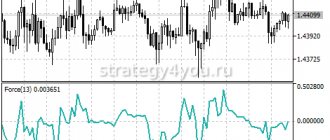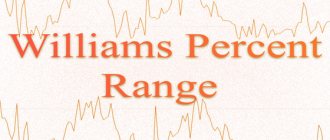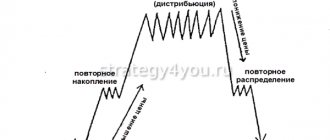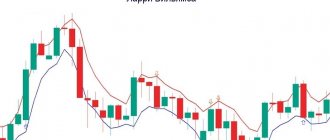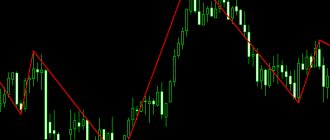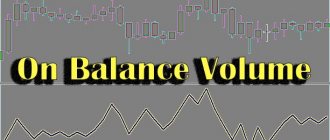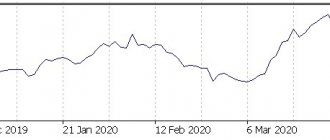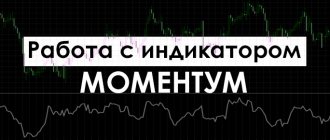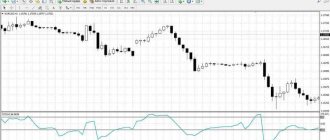The Market Facilitation Index (BW MFI) was created by Bill Williams at the time of a radical revision of approaches to technical market analysis. This talented theorist and practitioner’s new vision for forecasting and assessing trends was outlined in the book “Trading Chaos,” which gave traders both individual indicators and full-fledged trading systems.
In today's material we will take a closer look at the indicator of the legendary trader.
Indicator characteristics
Platform: Any Currency pairs: any Time frame: any Trading time: 24 hours a day Recommended brokers: Alpari, RoboForex, Amarkets
The Money Flow Index (MFI) indicator shows the rate at which money is invested in or withdrawn from a security. MFI is very similar in principle of operation and calculation to the RSI indicator, only it additionally takes into account volume. Essentially, this indicator measures the selling and buying pressure. MFI is plotted in the footer of the graph and ranges from 0 to 100:
You can find this indicator in your MT4: Insert>Indicators>Volumes>Money Flow Index. On our forum you can choose a custom indicator to your liking from a large set kindly created by forum member Pavel888.
An unmodified indicator usually has only one setting - its averaging period, which, as a rule, is set to the same as that of the RSI indicator - 14.
Description of settings
The Market Facilitation Index indicator can be found in the Metatrader trading platform through the Navigator or the “Insert” menu, the “Indicators” option in the “Bill Williams” section.
The histogram does not have numerical settings, only color gamut. On the “Levels” tab, a trader can display the line values that are convenient for him.
Principle of operation
The MFI indicator calculates the difference between incoming and outgoing cash flows. If the underlying value of the asset is below this difference, then this means that there is an increase in the incoming money supply and a bull market. If we see the opposite, it means that investors are leaving the instrument and the market is bearish.
Thus, MFI compares the ratio of positive and negative cash flows. If the typical price for the current period is higher than for the previous one, this indicates a positive inflow of money into this asset. If the typical price for the current period is less than for the previous one, it means that investors are withdrawing funds from this asset.
Like the RSI indicator, support and resistance levels are at levels 30 and 70, or 20 and 80. The recommended period of the indicator is 14, but you can choose the best option yourself.
Calculation
Money Flow Index uses in its calculation the concept of typical price (Typical price) - the quotient of dividing the sum of the maximum, minimum and closing price by 3. The basic concept when calculating the Money Flow Index will be Money Flow (cash flow), which is determined by the product of the typical price of a given period on trading volume for the specified period.
Money Flow(i) = Tp(i)*Volume(i), where Money Flow(i) is the amount of money flow for the period, Tp(i) is the typical price for the period, Volume(i) is the trading volume for the period.
The next step is to classify the current cash flow as either positive (Positive Money Flow) or negative cash flow (Negative Money Flow). If the current typical price is greater than the previous one, then Money Flow is positive; if it is less, it is negative.
At this stage, the Money Ratio is calculated as the quotient of dividing the sum of positive cash flows for a specified period by the sum of negative cash flows for the same period.
Money Ratio = ∑(Positive Money Flow(i))/∑(Negative Money Flow(i)).
And at the last step - directly calculating the Money Flow Index, as the difference of 100 and the quotient of dividing 100 by the amount of 1 and the monetary ratio.
Money Flow Index = 100 – (100/(1+Money Ratio).
It is worth noting that the Money Flow Index does not use an averaging model in its calculation, and the choice of period is only a time period in which positive and negative cash flows are highlighted for their further comparison. Consequently, the Money Flow Index indicator is synchronous with the price, and in some situations even leading.
Really Important MFI Indicators
Again, we resort to the recommendations of the creator of this amazing BW MFI indicator. Where Bill Williams pays special attention to instrument signals through complex analysis . That is, it implies that you should not focus only on the last or emerging bar. For a more objective assessment of price dynamics, it is necessary to take into account not only the current bar and the past (already closed) column. But it will be no less important to take into account the previous index.
To tell the truth, I myself once speculated on this indicator and, at the same time, listening to this recommendation, came to a conclusion that was surprising to me. By combining for your entry points different options of 2, 3 different-colored (and single-colored, including) indices in a row, you can identify a full-fledged trading system based on optimal entries into the market. That is, a certain algorithm of actions, which can subsequently indicate the optimal moments for making a trading decision.
Complex combinations of MFI indexes.
Moreover, having repeatedly tested one or another combination of a palette of indices consisting of both 2 candles and 3 indices in a row, they free the “fragile” trader from the emotional burden. Otherwise, under the influence of hyperkinesis syndrome, there is a high probability of relapse of a psychosomatic brain disorder. In common parlance – a chronic nervous tic! *This is not an attempt to stand out, but real events (verified personally)!
But as you understand, there are a great many such combinations. I myself, who does not have a high IQ, could not count the number of combinations. Taking into account the sequence! But nothing prevents you, as future investors and ordinary traders, from identifying for yourself the most effective combinations of color indices. Moreover, now there is everything necessary for this, strategy testers, development and creation of robots and advisors, backtests in both MT4 and MT5. At worst, you can use the banal history of quotes!
Using Money Flow Index in trading
Well, now let's move on to the most interesting question - how to use this indicator in trading? Since MFI is very similar to RSI, it produces three types of signals. These include exiting overbought/oversold zones, divergence and formation of patterns.
Overbought/oversold levels
Since the Money Flow Index is a typical oscillator, the most common signal will still be the indicator line leaving the overbought/oversold zones. Moreover, when a trend begins, the Money Flow Index, like all other oscillators, can get stuck in the corresponding zone for a long time. Therefore, the indicator needs a trend filter.
Traditional overbought territory begins above 80, and oversold territory begins below 20. However, these values are subjective, and you can certainly set whatever thresholds work best for a given instrument.
Crossing the median line
If you plot a straight line on the MFI chart at the 50% level, you can use its intersection as an additional confirmation signal.
Crossing this level from bottom to top indicates increasing buying pressure and is a signal to buy. The crossover from top to bottom shows that sellers are gaining strength and sell positions are now a priority.
Divergence
MFI divergence occurs when there is a difference between what the price action indicates and what the MFI indicates. These differences can be interpreted as an impending reversal. Specifically, there are two types of divergences: bearish and bullish.
There is already a lot of information about divergences on our website (use the search in the upper right corner), so there is no point in repeating it here. This is a fairly powerful and accurate signal for any oscillator.
Graphic models
Sometimes a trading method is used in which resistance and support levels, trends and technical analysis patterns, such as double tops or heads and shoulders, are monitored on the indicator chart. Particularly reliable signals can be considered those that appear simultaneously on the indicator chart and on the price chart. This method of trading is quite specific, since much here depends on the subjective view of the trader and his interpretation of what is happening. Let me just say that finding a good pattern on the MFI chart is quite difficult.
Algorithm for forming the MFI index
Let's say we have a rising bar/candle on the 15-minute timeframe. During the first 5 minutes (if observed on the 5-minute chart display), the bar grew and amounted to 25 points. During this time, 150 ticks occurred. Accordingly, the MFI index will show us an increase in the value of 0.1667. In the next 5 minutes, the candle was 68 points, and the volume indicator was 242 ticks. This means that market relief increased to 0.2810.
Now, after 10 minutes, the 15-minute candle ends with indicators; bar – 23 points, volume – 220 ticks and MFI – 0.1045. Thus, we can conclude that dramatic changes in the MFI index do not provide us with valuable information for making an appropriate trading decision. Based on the above, many professional market participants and adherents of technical analysis attribute this indicator to a related relationship with market volatility!
Video lessons by Artyom Zvezdin
VSA analysis must be studied consistently, otherwise there will be no point.
I suggest you plunge headlong into awesome video lessons from the pros. Find out everything about VSA and get tips and secrets
Moreover, this indicator (column height) can lead an amateur trader to make mistakes and make the wrong trading decision. And, as a result, to sad consequences for the trading account. Because this indicator of market facilitation has a significant drawback. Namely, MFI columns can show both growth and decline. Why is this happening?
It's simple; if players do not show interest in the market, and the price at this time moves “in pairs” of previous initiative transactions, then the dividend (number of points) will be many times greater than the divisor (volume of ticks). And as a result, we get a “distorted” picture, in which the price stands still (in the interpretation of the higher timeframe), and MFI volumes grow. It is precisely because of such anomalies that you should not look at Bill Williams' histogram as vertical volumes.
Testing the indicator
I decided to test the processing of simple indicator signals given at the intersection of overbought and oversold levels, as well as level 50. I took one EURUSD currency pair on the D1 period and several signal options. At the same time, I used various options for trailing stops, stops based on ATR and closing based on various signals from other indicators. All parameters for exiting and maintaining a position were optimized once when using the entry option using another indicator, in order to eliminate the adjustment of parameters to the specifics of the MFI indicator. Next, I conducted several tests with these parameters without changing the indicator parameters.
Option 1 – buy if MFI(7) crosses level 30 from bottom to top, and sell when crossing level 70 from top to bottom:
Option 2 – reverse first option:
Option 3 – MFI rises for purchases and falls for sales:
Option 4 – MFI greater than 50 for purchases and less than 50 for sales:
Option 5 – MFI grows and above 50 for purchases, falls below 50 for sales:
Option 6 is a reverse option (like option 2), but with an MFI period of 21:
The only normal option for using the overbought/oversold levels of the MFI indicator is the intersection of the overbought levels by the indicator from top to bottom for sales and the oversold level from bottom to top for purchases, which is to be expected.
Subscribe now:
Telegram
In order for it to happen as you claim, that is, the complete absence of a brown index, it is necessary that the price completely stop and there are no traders at all. Suppose, at least for the 1st minute (timeframe M1). As you understand, this is impossible! This leads to a logical conclusion and, at the same time, the statement of Bill Williams that this brown index signals us about a slowdown in the current trend.
By the way, this bar is brown and is also not used for making trading decisions. It only acts as additional filtration. Both in price analysis and in direct trading. Natural strategist Bill Williams associates the brown color of the index with the adjective state of the market, “decrepit,” “withering,” or “withering.” By this we mean a loss of interest among traders in a given asset and/or the current trend.
Blue color of the MFI index.
When a blue bar appears in the MFI histogram, the following player interactions occur: The MFI index grows, respectively, its growth can be explained by the fact that, according to the formula, the dividend increases (High – Low), and the divisor (Volume in ticks) decreases. Yes this is true. But what could be the reason for such interaction? And here, one single intelligible explanation suggests itself:
The decline in volume against the background of an increasing trend is explained by the lack of interest of traders, but at the same time the market is dominated by previous initiative transactions. And while the price is in the potential for movement, the decline in volumes tells us that for the active players in the market, a sufficient number of counterparties have not yet been found.
However, there is room for another, no less rational explanation. Thus, a decline in volumes against the backdrop of a price trend may indicate that large players are trying to establish some control over the movement. Provoking adventurers to enter the market against the real trend. And we all understand the consequences of trading on an “artificially” created change in the exchange rate value of an asset! In simple terms, MFI is growing, but volumes are decreasing.
Williams Bill warns his followers that during the formation of the blue column, it is advisable for traders to refrain from trading. This recommendation especially applies to novice players who are not yet able to evaluate all variables as objectively as possible. Bill Williams assigned this index to blue because of the association that the color blue is characterized as “fake,” “fake,” or “unnatural.”
Pink color of the MFI index.
The pink color of the MFI, and in our case the red color of the column, opposite the blue column, tells us about a decline in the index and an increase in volume. Of the entire palette of colored columns, the pink bar is the only index that, to one degree or another, can relate to signal indicators. The creator of this tool, with an analytical mind, believes that special attention is needed when forming the pink stripe.
Since it is with a fixed pink column (at the end of the period/candle/bar), the trend has priority in stopping the movement. And as a consequence, good potential for changing the direction of the trend! In any case, entering a position on a pink signal is an optimized trading decision. And confirmation of a correctly made decision, as you already guessed, is the appearance of the subsequent green semaphore.
The red element of the histogram, by the American M. Williams, is characterized as “landing”. But what happens in such a ragnarky of bulls and bears? If we analyze the growth in volume when the index is red and falling, it turns out that traders are active. However, if MFI falls, then it turns out that the price is slowing down. This suggests the conclusion that either the counterparties of the initiators enter the market, or the initiators of the movement themselves exit their positions.
conclusions
The Money Flow Index indicator is a kind of variation of RSI that takes into account trading volume. This is where the properties of this indicator come from. Since the value of volume is difficult to overestimate for the analysis of an asset, the Money Flow Index is more preferable for analysis than the RSI.
The price of a financial instrument and its correlation with momentum is a very important indicator for any technical analyst. A cash flow index can be a very valuable tool. Of course, MFI should not be used as the sole source for signals, just like any other indicator. Since this is an oscillator, it is quite logical to use it to determine a specific entry point, while determining the current trend using one of the trend indicators.
Forum thread
Best regards, Dmitry aka Silentspec
Relationship between volatility and MFI
From the analysis of the calculation formula presented above, we can state that BW index indicator are the ratio of the volume in points of the candle/bar to the tick volume for the selected period of time! But the creator Bill M. Williams himself, although he confirms this definition, however, he summarizes the following; “Growth, decline or any other change in the value of a column does not carry important meanings. It is much more prudent to pay attention to the previous bars of the histogram!
What did Williams mean by this? The fact is that this index indicator, a priori, cannot be objective. Since “unreasonable” volatility demonstrates not entirely reliable indicators of the MFI histogram index. The term “unreasonable” refers to some market fluctuations that do not have the initiative decisions of the players. To understand this, let’s delve into the essence of the formation of BW MFI columns.

